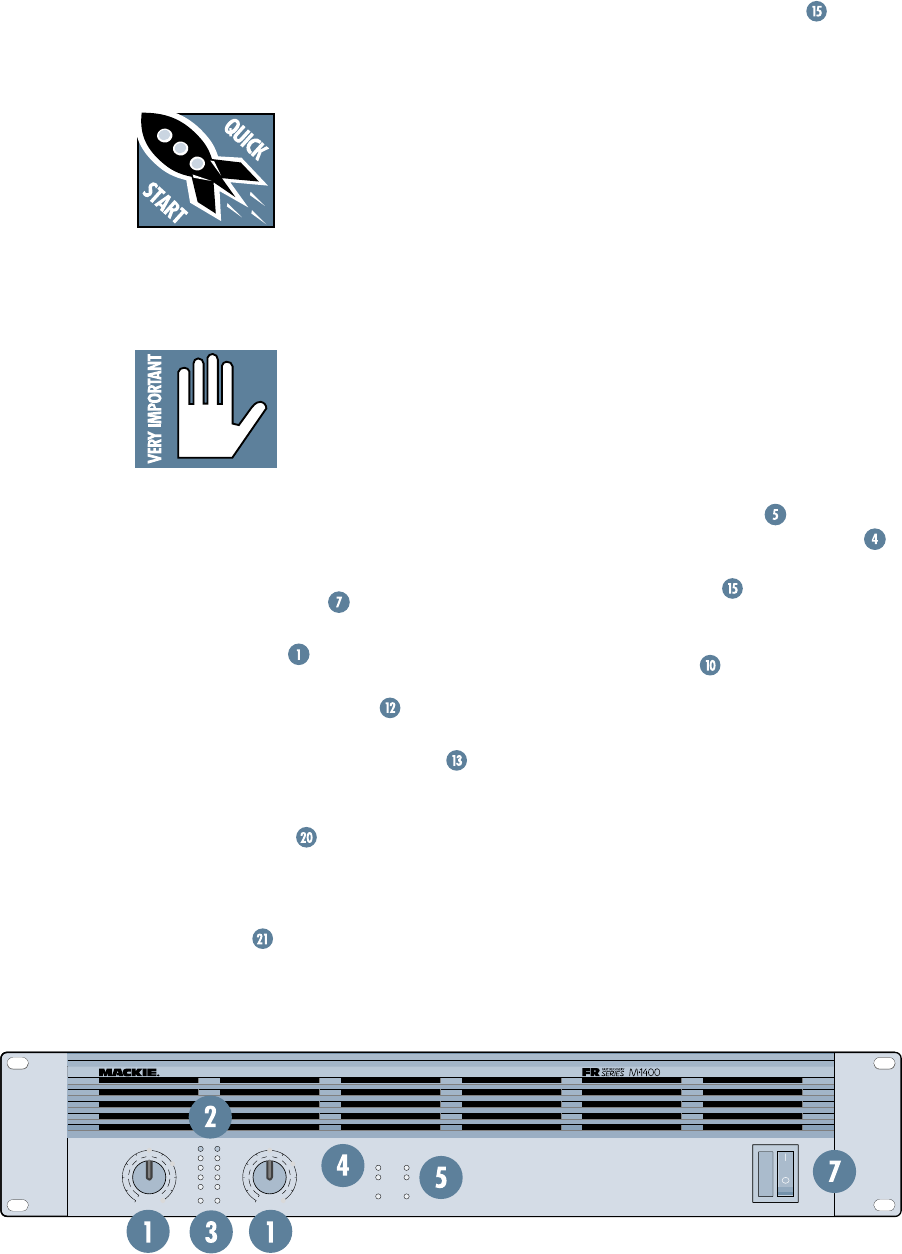
4
READ THIS PAGE!
6. Determine which
AMP MODE
is best
for your application:
•
STEREO
mode (separate left and right
inputs, separate left and right outputs) is
the typical setup for amplifying stereo signals.
•
MONO
mode (sometimes called Dual-
Mono mode – one mono input, two mono
outputs) is for sending a mono signal to
two different speaker sets, with separately-
adjustable level controls.
•
BRIDGE
mode (sometimes called
Bridged-Mono – one mono input, one
mono output) uses both sides of the amp
to double the power to one speaker set. An
M•1400/M•1400i power amplifier, set to
BRIDGE
mode, delivers 1400 watts (into 4
ohms). Garsh!
Note: 4 ohms is the minimum impedance
you should connect to the amplifier in
BRIDGE
mode. If you connect a lower impedance load
in
BRIDGE
mode, the
SHORT
LEDs may
light, putting the amplifier into
PROTECT
mode.
Set the
AMP MODE
switch accordingly.
7. In
STEREO
mode, connect line-level cables
from your signal source to the M•1400/
M•1400i’s
INPUT
jacks, either XLR or
TRS:
• The XLR and TRS inputs for each
channel are wired in parallel.
• The balanced XLR inputs are wired
pin 2 = hot (+), pin 3 = cold (–) and
pin 1 = shield (ground).
• The 1/4" TRS inputs are wired tip = hot
(+), ring = cold (–) and sleeve = shield
(ground), and can accept either balanced
(TRS) or unbalanced (TS) cables.
QUICK START
I got ants in my pants and I got to dance!
INSTALLATION
The M•1400/M•1400i amp
can be mounted in any
standard rack system (see
page 23), or placed horizon-
tally on a floor or table. The
heavier internal compo-
nents are located towards the front of the
chassis to make it easier to hold the amp by its
front handles.
IMPORTANT: The ampli-
fier draws its ventilation
air in from the front and
out through the side pan-
els. It needs plenty of fresh
air to stay cool.
DO NOT BLOCK THE VENTILATION PORTS
(see page 23).
CONNECTIONS AND SETTINGS
1. Be sure the
POWER
switch is off before
making connections.
2. Turn the
GAIN
controls fully down
(counterclockwise) for now.
3. Set both
LOW CUT FILTER
controls to
their
TYPICAL
marks (35Hz).
4. Set both
CONSTANT DIRECTIVITY
switches
OFF
(unless you’re using constant
directivity horns with compression drivers).
5. Set the
LIMITER
switch on.
Note: If you’re using the M•1400/M•1400i to
power a subwoofer, you probably do not need
an external crossover. Please see
SUBWOOFER
on page 21 for details.
OL
–3
–6
–9
–20
–3
–6
–9
–20
SIG
OL
SIG
CH
1
30
28
26
20
22
18
2416
14
8
0
0
1.23v (+4dBu)
SENSITIVITY
GAIN/dB
CH
2
PROTECT
COLD HOT
SHORT
TEMP STATUS
INTERNAL STATUS
CH
1
CH
2
CH
1& 2
ON
OFF
POWER
3v
2v
1v
30
28
26
20
22
18
2416
14
8
0
0
1.23v (+4dBu)
SENSITIVITY
GAIN/dB
3v
2v
1v
PROFESSIONAL POWER AMPLIFIER
FULL SYMMETRY DUAL DIFFERENTIAL HIGH CURRENT DESIGN
